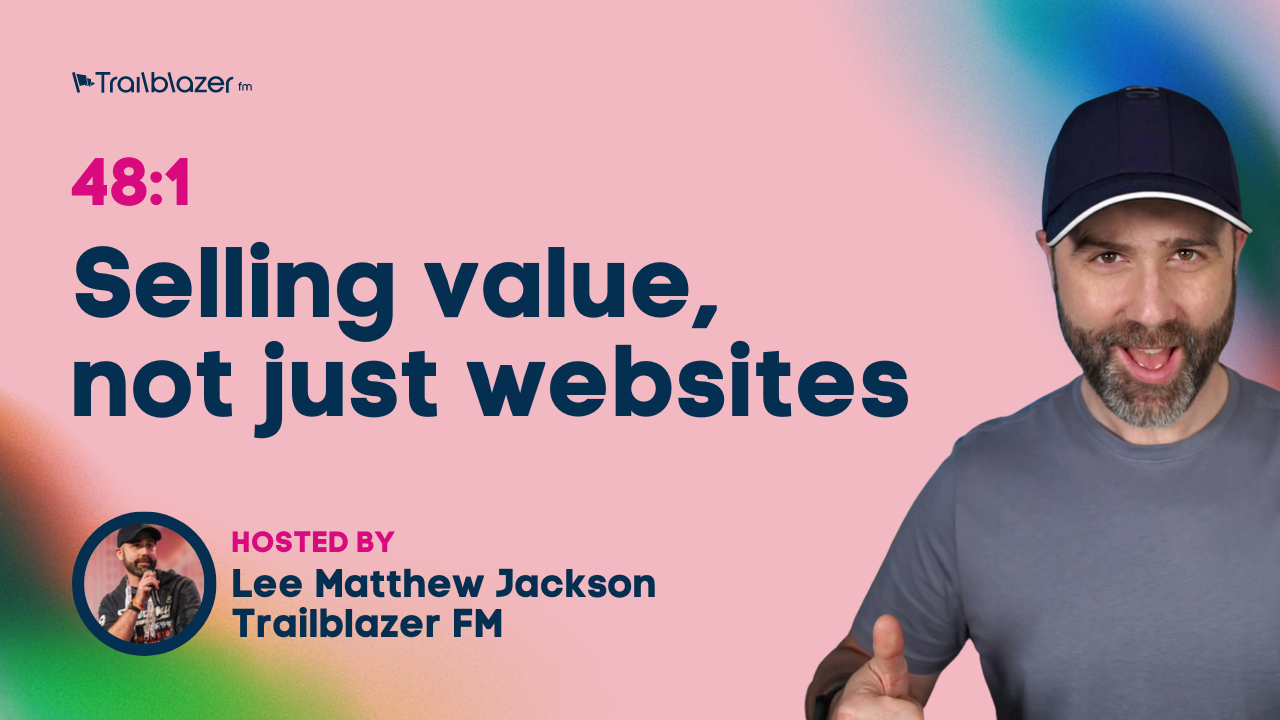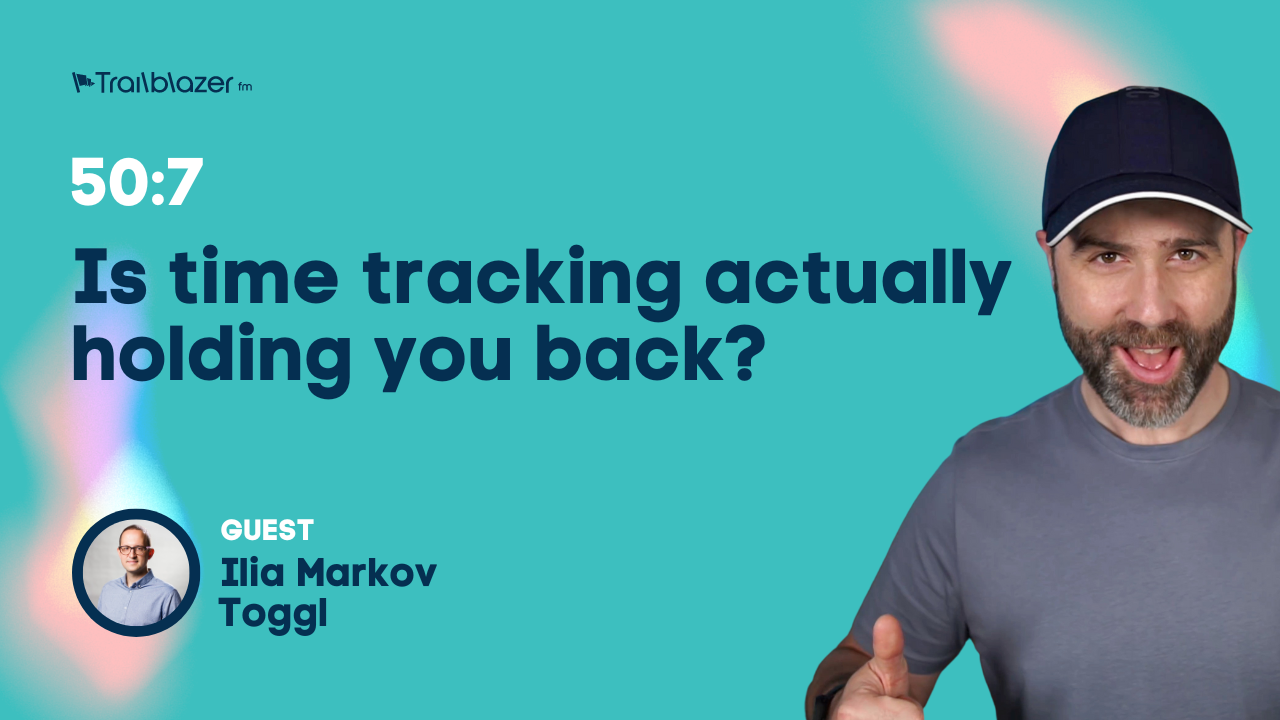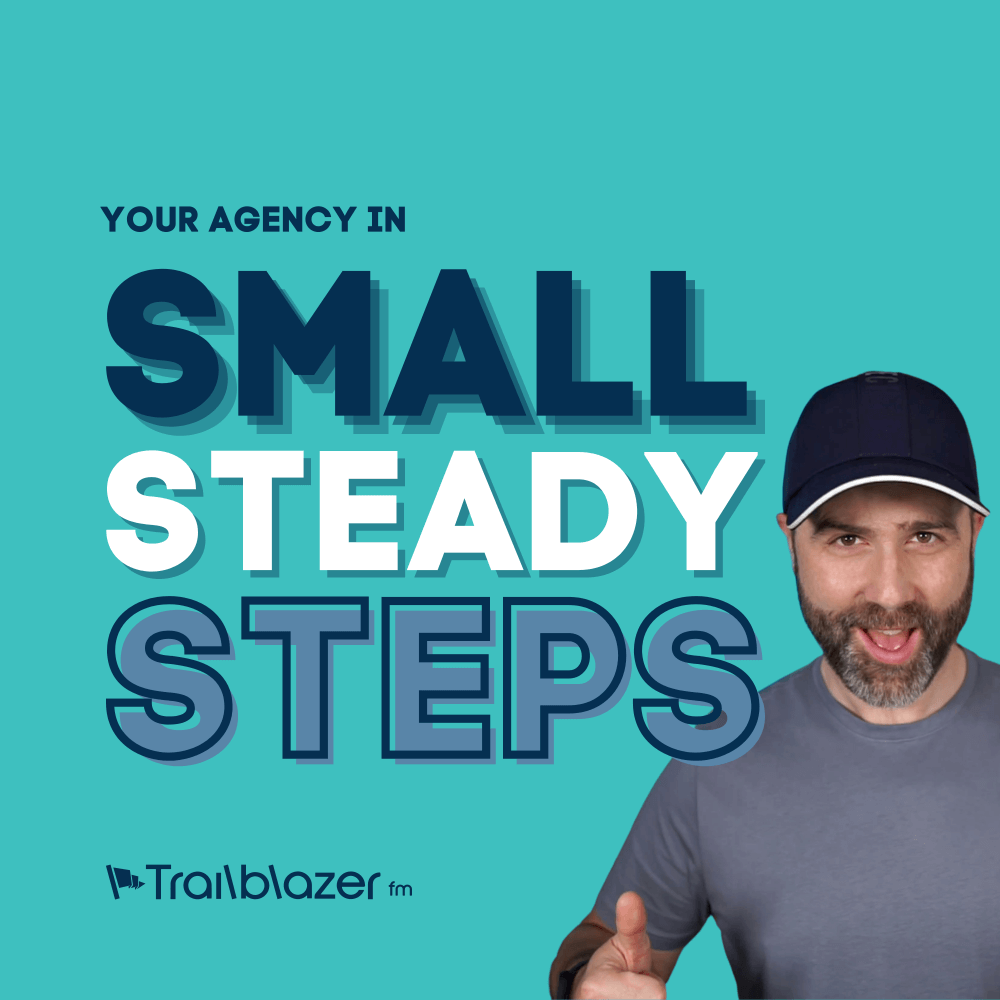
48:1 Selling value, not just websites
Discover a better way to sell your web design services to potential clients.
Are you tired of trying to sell your web design services to potential clients, only to be met with hesitation and skepticism? It can be difficult to convince someone to invest a large sum of money in your services when they don't really know you yet. But what if there was a better way?

In this episode of the Trailblazer podcast, Lee shares his approach to selling web design services as a consultant first.
By building a relationship with potential clients, understanding their goals and blockers, and offering a low investment discovery process to identify solutions, Lee has been able to establish profitable and long-lasting relationships with his clients.
If you're tired of the traditional approach to selling web design services and want to learn how to position yourself as a consultant first, this episode is for you.
Key takeaways
- As an agency owner, it's important to avoid simply selling the features of your product or service, and instead take a consultative approach.
- The first step in the process is connecting with potential clients and building a relationship.
- During this initial conversation, it's important to focus on the client's goals and aspirations, as well as identifying any blockers.
- Rather than jumping straight into a large project, offer a low investment discovery process to help the client find a plan to overcome the blockers.
- Once the discovery is complete, quote for the implementation of the solutions you identified.
- Over time, this approach will lead to larger projects and a stronger, more profitable relationship with the client.
The process
- Connect with potential clients and discover their goals and aspirations
- Identify the blockers that are stopping them from achieving their goals
- Present solutions through a low investment discovery process
- Quote on the implementation of the solutions
- Build a relationship with regular conversations and approach bigger web projects through the same discovery process
Summary
Don't just sell websites or products. Sell value and build a relationship with your clients. By identifying problems and providing effective solutions, you can position yourself as a valuable consultant and build a lifetime value client based on mutual trust and respect.
Join the conversation and share your biggest takeaways in the comments below.
Transcript
Welcome to the Trailblazer podcast. This is your host, Lee. In today's show, we're going to focus on how consultancy leads to profitable web projects. Let's set the scene. And in most circumstances, as a web agency, you may get a lead. You will position your amazing services and showcase how great you are. We've built all of these fantastic websites. We've worked with all of these wonderful companies. We will be able to build and design whatever it is you need. Now, please pay this extortionately large amount of money based on what we've just told you. I don't mean extortionately, that just came out. But anyway, but let's focus here on how hard that is. It is really hard. As far as the client or the potential client feels, they think it is an extortionate amount of money because they don't really know you. They want a website build, they know that. You've given them a rather large price in their view based on being able to showcase some stuff you've done for other people. But the problem is they don't really have a relationship with you yet. They don't really know, like and trust you yet. As agency owners, we're very tempted to approach our selling process by selling the thing that we do, the features of the thing that we do, the features of the product that we have, etc.
And yet what if we could turn that on its head? What if we could actually have a conversation with a client and find out what their aspirations are, then work out what the blockers to those are and then present solutions. I know it sounds really simple, but I'd like to share with you the process flow that we have in Event Engine for attracting new clients and converting them and essentially working with them over a period of time, which always does lead to really good, fun, profitable web projects. The first stage of our process is connecting with the new lead. Very often we will have some form of basic brief like we're looking for a new website that will allow us to do X, Y, and Z. The natural inclination is going to be to jump on a call and ask them what features they need, how many pages, what their budget is, and when do they need it by. That then leads to that problem that we really have to prove ourselves. What we now do instead is get on a call and really start to try and find out what it is that our potential client wants to achieve.
What are their goals? What are their aspirations? During that, we'll obviously take some initial notes, which will help us to reverse brief, and we'll also then start to try and unpack what some of those blockers might be. What is it that's stopping them from achieving those particular goals? What are the goals that they have with this website? Why doesn't their current website allow them to achieve those particular goals? This conversation really allows us to understand our client and what it is they're looking to do. It also allows us to position the next step in working with us, and that's not to build a website, but for us, it's in fact to engage in some form of discovery. That doesn't necessarily even have to be the discovery for a website, but it could even be just some form of discovery to help unblock something that is stopping them from achieving their goal with their existing set up. It could be that they already have, say, a WordPress website, but there is just some gap in their process that means they're having to double enter information or they're losing things. How about we engage in some form of small paid discovery where we take a look at what you have, what you're trying to achieve, and we put forward some potential solutions that might solve that problem and give you more time to plan for the bigger picture.
And yes, this does sometimes mean we do ourselves out of a massive website project, at least initially. But what it does allow us to do is test the relationship. They get to spend a smaller amount with us. We help them understand the problem they have and how they might be able to fix it. This in turn builds credibility with our client and the likelihood that they're going to continue with us in their journey. Usually, what would then happen is we would quote on the implementation for the solutions. They've already worked with us. They like us. Yes, of course, they're going to go ahead and get us to implement those particular solutions. What now happens is we can develop a relationship of regular conversations with our client. We've onboarded a new client for a low amount of money. They've developed some trust with us. They've invested a little bit more to get a solution. They're starting to see some results. They're still considering the bigger picture, the bigger build, and they have that regular conversation, that regular trust, that regular connection with us. We can then approach the bigger web project in the same manner by going through the same discovery process and then planning the bigger build.
We are better equipped as an agency because we understand how they operate. We know a lot more about their business because we've actually worked with them. We are much better suited to be positioning a web build, to be planning a web build with them than we were when we were simply just trying to prove how good we were and hoping they would just jump on board and trust us with pretty much no other creds other than what we said we've done for other people and what we can show them on screen or on paper. Now, I know this isn't rocket science, but let me share with you a problem that we had in Event Engine. We've developed a content management system for the events industry. We've based it on WordPress, and we now licence it to hundreds of events all around the world. In the past, we'd often be trying to approach potential clients who had multiple events with our product and some form of licensing agreement. The problem is we were just leading with a licence. We were saying, Hey, look, pay this license, you'll have our platform and then you're on your own, crack on and build your own websites.
For us, there were two issues with that. Number one, it was just really hard to sell and position that. And then secondly, we didn't really have the satisfaction of working with them and being a part of their team. So when we turned that on the head and went for this consultative model approach, it meant that we could onboard way more clients. Many of them may never even come on board with the product itself, but some would. And those that would would be those high value customers who will stay with us for much longer than just the average churn rate of, say, a website or of a licenced product. If you imagine many websites will last maybe three or four years before the client wants to go ahead and buy a new one and will probably go to a different agency. It's the same with, say, a SaaS product or a licenced product. I'm really, really proud that some of our clients have been with us for over 10 years using our licenced product. But again, they were on boarded through this exact process of first of all, developing the relationship with something small and then building upon that over time.
So to sum up this episode, essentially in a paragraph, the process includes connecting with the potential client, discovering what it is they want to achieve, identifying the blockers, then selling a low investment discovery process to help them find a plan to crush those blockers. This, of course, allows the customer to test working with you at a lower cost and allows you to build the credibility and to show you know your stuff. At the end of the discovery, you then quote for the implementation of the solution that you've identified, and this again leads to larger projects over time as you begin to be perceived as part of the team and you get drawn into those other projects. This creates a much better lifetime value client as opposed to trying to churn over multiple one off website builds. If you've had value from this episode, can I encourage you to go to the show notes, click on the link in there and join me in the comments by sharing what your biggest take away was. Also, please, can I encourage you to share this episode with your friends. That is how we can grow and get our message out there.
In fact, it's probably going to be one of the only ways that we will grow because at a personal level, I have taken a massive break from social media and personally plan to continue to do so. So other than some basic broadcasting tweets and posts that will go out from the team here at Trailblazer FM, your sharing is actually what will help us grow. So I would really appreciate that. Again, please do join us in the comments, but if we don't see you in the comments, then how about we see you in the next episode?








